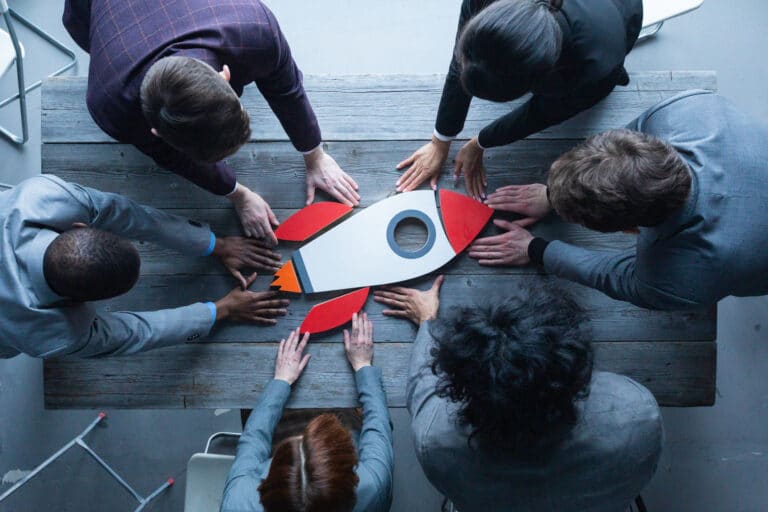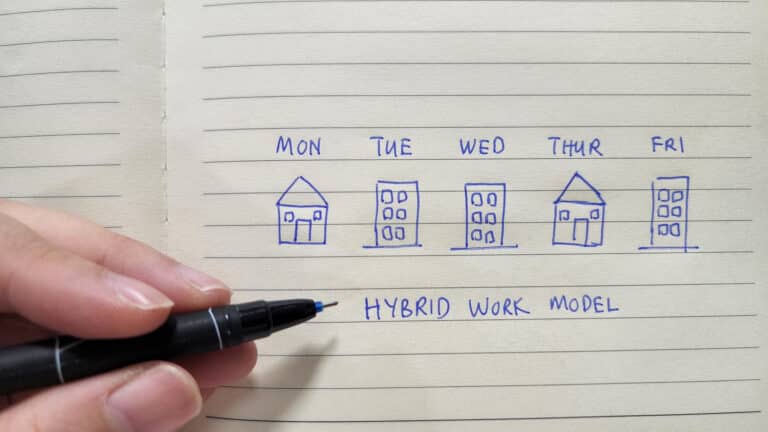Creative thinking, opening the way to new solutions, new products, and new success, relies on a two-step process. This begins with the freedom to suggest new things, the best of which are then developed into a tangible proposal. Creativity can’t be faked. It can’t be forced, completed by lunchtime, or restricted to some in the room but not others. Inspiration only thrives when people are allowed to come up with untried, novel ideas. Creative thinking can give you practical solutions, as long as the process that leads to them is given the room to breathe.
What is creative thinking?
Creativity is the development of original ideas, creative thinking is the skill that cultivates these and transforms the best into practical options. Although we all have a pretty good idea of what creativity is, it’s hard to pin down in a detailed definition that resonates with everyone. And not everyone realises that it can be a thinking process – something we might do systematically. It’s because we associate the word ‘creative’ with concepts like subjectivity, chance, play, art, imagination, randomness, freedom and irrationality. We’re right to do so, because all of those things are involved. But they describe only half of the picture. And the other half of the picture is systematic and methodical.
This is because creativity has these two aspects: originality and productivity. Both sides are important. We can’t be creative unless we come up with something new, but neither can we be creative unless the new thing we come up with is of practical benefit.
It’s from the uncontrolled, open, part of the process where we let our imaginations run wild that we get our originality. And in order to get our productivity, we need some sort of process, where we logically, systematically, narrow our ideas down to a goal.
The challenge to being more creative lies in bringing the irrational and rational together so that we get a valuable end product; whether the end product is Sergeant Pepper, the iPhone, or an improved employee recruitment process, the principles are much the same.
Why is creative thinking important?
Creative thinking is a key component of the future skills that are vital to business success. Here are three quick reasons:
- Competition – With greater globalisation and digitalisation of so much industry, competitors are everywhere and able to access the same customers as you. That’s why a unique selling point, a new product, or a better solution can be the only way to stay ahead. Creativity is going to be needed to provide that.
- Problem-solving – From engineering to customer service, all problem-solving has a creative element. Without it, we’d only be able to apply automated solutions, and we have AI to do that.
- Ownership – This is often overlooked, but people tend to be more committed to plans they feel ownership of. So, if they are creatively involved in a solution they are more committed to its implementation.
Types of creative thinking
Let’s start with the imaginative part of the process. For this, we want to generate a good quantity of ideas and for those ideas to be fresh, interesting and surprising. The most important consideration for this is the mental state of the people involved. If they are anxious, distracted, over-hyped, disengaged or otherwise not wholly present, the right parts of the brain just don’t fire up.
What we need, then, is a positive, constructive atmosphere, where people feel inspired, open and adventurous. Everyone present needs to commit to preserving psychological safety for everyone else. There is plenty of information available to help persuade you of the importance of psychological safety but, as you might have guessed, it’s not rocket science.
Hopefully, we all know how to make others feel relaxed and comfortable. So what goes wrong? Here are some common ‘spoilers’ of the atmosphere in a group that can obstruct creative thinking:
- Time pressure – don’t let the team feel that time is in short supply.
- Awareness of high stakes – keep the prospect of consequence (positive or negative) distant.
- Status anxiety and ambiguity – the leaders must demonstrate vulnerability.
- Fixed mindset – model a growth mindset, where mistakes are tolerated.
- Efficiency mindset – keep the atmosphere exploratory, accept waste, duplication, and irrelevance (in the short term).
Looking down that list, it’s easy to see why it can be hard to retain the right mindset for creativity when the pressure is on. Here’s a great piece on how to hold the line.
Narrowing your ideas into a practical plan of action
So, that’s the imaginative part taken care of. The next stage is what to do with all the ideas. Here is how you might methodically narrow lots of ideas down to one choice.
- Gather
- Group
- List the merits of each (not the downside for now)
- Refer to goals
- Prioritise one thing
- Gathering is straightforward. The main thing to remember is that you should preserve all the ideas that bubble up in the brainstorm, even if it seems obvious that some are impractical or not serious.
- Next, sort the ideas into groups. You have no way of knowing what these groups might be before the process starts. What you do is look at what’s in front of you and see what you notice. Once this is done, reflect on what the grouping reveals. You are gaining a deeper understanding of the landscape of the problem/solution.
- Then take each idea and list the merits of each. This is not an evaluation of the idea, exactly. You are focusing only on the positive features it has. As you do this, ask yourselves ‘is this a feature we’d like our solution to have?’. If the answer is ‘yes’, you can start to think about how you can focus on pursuing that feature, even if the particular idea that sparked the conversation is not a goer.
- Now you’re going to need to refer back – or forward! – to your team’s goals: why are we doing this? What would success look like? What would an ideal solution deliver for us? Use these principles to start evaluating the ideas you’ve gathered and grouped. This means looking at drawbacks (notice how late in in the day we let ourselves consider drawbacks!) You’re getting down now to what really matters.
- You may find yourself deadlocked. Then it’s time to prioritise one thing. For example, option A has an outstanding feature but some drawbacks, while option B has a different outstanding feature but some other drawbacks of its own. Unless you have an agreed framework with weightings for each feature (like that used by Research & Development departments in large firms) it’s difficult to try and compare because you’re not comparing like with like.
To prioritise one thing, look back at the goals to identify the most important criterion: this is the central feature that you’re trying to maximise. Other criteria then have to fall within an acceptable range but may not be maximised. This is actually something you do all the time. Take shopping. You are buying a new washing machine. You can’t have one that is stylish, fast, ecological, and cheap. You make a choice about priorities. For example ‘I will choose the one that looks most stylish…’ (that’s the criterion you’re prioritising), ‘…as long as it doesn’t take more than two hours to get the clothes clean and is not over £500’, (defining an acceptable range for the secondary criteria).
Notice how systematic this second part of the process is, in contrast to the loose, open, first, stage. Good creative thinkers ensure both parts of the process are in place, and they don’t let one part spoil the other.
Can creativity really be systematised?
What you might be wondering is whether highly creative people follow this structured approach. The answer is, yes and no. What they do well – because they’ve had so much practice – is jump between the stages more quickly than people who only have to be creative now and again. They also mix up the stages because they’re able to juggle the generation of ideas and the evaluation of ideas at the same time. Most of us need to keep these phases separate, especially when working in groups.
But even experienced creatives get stuck. And that’s when they will try to figure out which part of the creative process to jump start: should they try to spark new ideas, or narrow down the options, or remind themselves of the overall goal.
How can you start this today?
Here are some straightforward starting points to prepare your team to be more creative:
- Clear space and time for creative sessions.
- Frame creative sessions as ‘workshops’, ‘brainstorms’ etc rather than long meetings.
- Tell people what creative habits you’re trying to instil in these sessions and why.
- Introduce people to the ‘yes, and…’ principle from comedy improvisation.
- Encourage mistakes, jokes, tangents, fantasies, etc in creative sessions – these are all signs that the creative areas of the mind are up and running; self-censorship kills creativity.
If your professional development goals for work include brushing up on critical (or ‘agile’) thinking, maybe consider taking a course that will help to make the subject a little clearer. Our future skills courses on creative thinking and scientific thinking support a range of familiar situations at work, from developing new products to managing unexpected challenges. Rather than throw a task to the team and hope they come up with a solution, leaders can give them processes that will help them stay on track. Through creative, divergent thinking – leading to a range of ideas – followed by a convergent process shaping things into a practical plan of action, leaders can pursue a little blue-sky thinking while still keeping everyone’s feet on the ground.





